Military leaders since Alexander the Great have often preferred to command their battle formations from the most forward ranks. “Leading from the front,” as the practice is often known, puts officers in outstanding positions to observe the action and inspire their soldiers. It also puts them in excellent positions to end up dead. Many officers on both sides led from the front during the American Revolution and the act cost some of them their lives or at least gave them some very close shaves. Following are 10 instances when great Revolutionary War leaders put themselves in harm’s way, and the results often affected the course of the war. 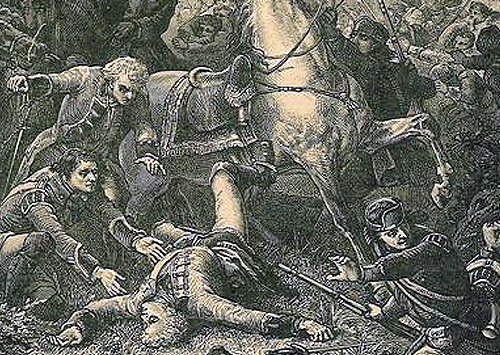
1. Washington at the Battle of the Monongahela
The “Indispensible Man” for the Americans barely lived to see the Revolution. On July 9, 1755, during the French and Indian War, General Edward Braddock’s column of British regulars and American militia were pushing through the wilderness towards France’s Fort Duquesne when French troops, Canadian militia, and Native Americans ambushed them near the Monongahela River, near present-day Pittsburgh, Pennsylvania. George Washington, then but an eager 23 year-old Virginia militia officer, fought heroically as Braddock’s volunteer aide-de-camp even after the general was mortally wounded. “I luckily escaped without a wound, though I had four bullets through my coat, and two horses shot under me,” Washington wrote on July 18.[1] You cannot help but wonder how profoundly different, to say the least, the Revolution would have been if one of those bullets had killed Washington. 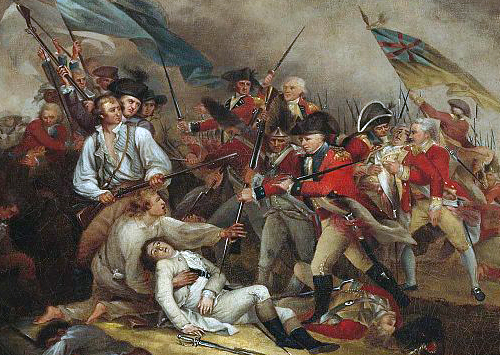
2. Warren at Bunker Hill
When it came to heavy hitters in Boston’s Patriot movement, nobody swung a bigger bat than Dr. Joseph Warren. He organized resistance to the British Parliament’s Coercive Acts, worked closely with John Hancock, Samuel Adams, Paul Revere and others in the Sons of Liberty, was instrumental in the creation of Patriot militias, served as President of the Massachusetts Provincial Congress, and that’s just a short list of his contributions. Just to get a chance to fight the British, Warren volunteered to serve in the ranks with Rebels fortifying Breed’s Hill, overlooking Charlestown, Massachusetts, on June 17, 1775, which was a week after his 34th birthday. He remained stalwart as British infantry assaulted the American redoubt in the ensuing battle that became known by the misnomer, Bunker Hill. A final Redcoat push surged into the Rebel works and there are contradictory accounts of what happened to Warren. However it is believed that Warren was one of the last defenders to retreat from the fort and that he tried to fend off the advancing Redcoats while attempting to rally his retreating comrades. In the melee, a British soldier, probably an officer’s servant, killed Warren by a pistol shot to the face that exited the back of the doctor’s head.[2] If not for that blast, Warren would surely have continued as an influential leader in the Revolution that he helped start. 
3. Howe at Bunker Hill
While ranks of British infantry attacked Breed’s Hill, British General William Howe confidently led an assault on a supporting line of Rebels positioned behind a rail fence on the side of the hill. Howe told his soldiers, “I shall not desire one of you to go a step farther than where I go myself at your head.” In two assaults that followed, he remained good to his word as volleys of American musket fire ripped into the British ranks. According to one account Howe was “in the most imminent danger” and a bullet even shot a wine bottle from the hands of his civilian servant, which was certainly a terrible waste.[3] The tall, handsome Howe in his general’s uniform made a great target for Rebel marksmen and he was lucky to survive without a wound. The first years of the Revolution would have been very different if Howe, whose less than aggressive approach as commander of British land forces in America contributed to the Continental Army’s survival, had died in 1775. 
4. Montgomery at Quebec
At the end of 1775 Major General Richard Montgomery was one of the Continental Army’s rising stars. An experienced former British officer, the affable 37 year-old ably commanded the American invasion of Canada in an attempt to bring the Canadians into the Rebellion. He once wrote that he “courted fortune, and found her kind.”[4] Montgomery certainly hoped for good luck when he attacked the fortress city of Quebec during a swirling snowstorm on December 31, 1775. He personally led one attacking column into the city, and fortune was with him right up to the point when they ran smack into a blockhouse that was well manned and armed. Montgomery ordered a charge and the defenders loosed a salvo of artillery and musket fire, killing him. The attack on Quebec failed, but a greater loss to America was the leadership of this promising young general. 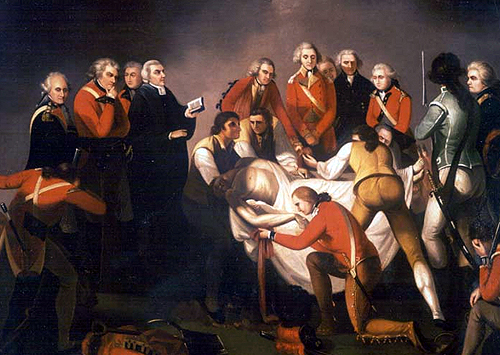
5. Fraser at Bemis Heights
During British Major General John Burgoyne’s invasion from Canada in 1777, one of his closest friends was the 48 year-old Brigadier General Simon Fraser. And both Burgoyne and Fraser bravely led from the front as their forces attempted to push south through New York and clashed with Americans at the battle of Bemis Heights on October 7. This was courageous but also a little foolhardy; among their opponents was Colonel Daniel Morgan’s regiment of skilled Virginia riflemen who literally looked for prominent targets like Fraser, who rode along his front line on a gray horse, rallying his soldiers. Morgan’s riflemen focused their fire on Fraser, and at least one bullet mortally wounded him in the stomach. Burgoyne lost heart and withdrew his attack as soldiers carried Fraser from the field.[5] The battle sealed the invasion as a failure, and 10 days later Burgoyne surrendered his army at Saratoga. 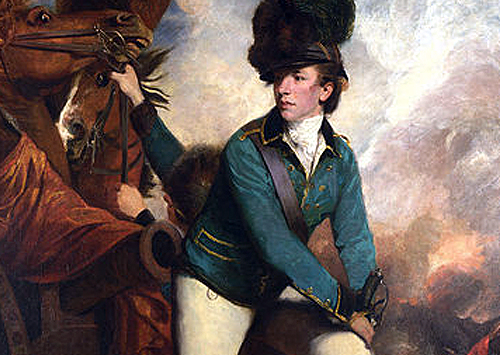
6. Tarleton at the Spread Eagle Tavern
In the first few weeks of 1778, British Brigadier General Sir William Erskine learned that a party of Continental horsemen was quartered at the Spread Eagle Tavern, about six miles from the main Continental Army winter camp at Valley Forge. On January 20, 200 light dragoons swept down on the tavern at dawn to bag the Americans. The bold, ambitious, and fearless 24 year-old Captain Banastre Tarleton led the charge and his men thundered towards the tavern, confident of success and hungry for glory. But commanding the Continentals was the equally bold, ambitious and fearless Captain Henry Lee, who barricaded the tavern and prepared for a fight. Lee’s men fired a volley from the tavern windows and five British dragoons fell dead from their saddles. One ball shot Tarleton’s leather riding helmet from his head, buckshot pierced his jacket, and his horse was wounded in three places. The tough American defense turned back the British attack.[6] The Americans escaped, and their captain became the famous Continental cavalry leader “Light Horse Harry Lee.” Tarleton rose to command the British Legion, and gained his coveted glory – or a version of it – as “Bloody Ban,” one of the war’s most famous, and infamous, cavalry leaders. 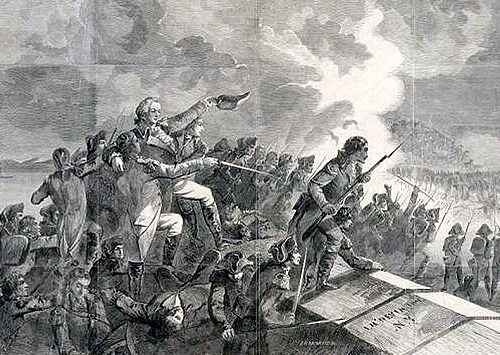
7. Wayne at Stony Point
Brigadier General Anthony Wayne was among the Continental Army’s best commanders. Just after midnight on July 16, 1779, he was in the forefront of a column of Continental Army light infantry as they stormed the British fortress of Stony Point, New York, on the west bank of the Hudson River. As his soldiers chopped through an obstacle belt at the base of the fort, British defenders loosed volleys of musket fire. The redcoats fired blindly into the pitch black night, but one ball caught Wayne in the head and cut a gash across his scalp. Scalp wounds bleed profusely and Wayne’s aides helped him along as his soldiers seized Stony Point. Wayne, who never minded a little extra attention, later wrote to a friend of the “blood which continued to issue in a torrent” from the wound.[7] Wayne survived the Revolution and in 1794, he defeated the Native American tribes in present-day Ohio at the battle of Fallen Timbers, a victory that helped open America’s west to settlement. 
8. Ferguson at Kings Mountain
The Scottish Major Patrick Ferguson was a tough, intelligent British officer who expertly adapted infantry tactics to fit combat in America. He was especially effective as commander of a Provincial Corps in North Carolina in 1780 until he threatened the local Rebels that he would “lay waste to their country with fire and sword.” Big mistake. About 1,800 tough and angry backwoods “Over the Mountain Men” trapped Ferguson’s corps at Kings Mountain on October 7. Ferguson rode all over the battlefield inspiring his men, but made a conspicuous target on his white horse and wearing a checked over shirt. A fusillade of at least 7 musket balls from Rebel marksmen shot him from his saddle, killing the aggressive Ferguson.[8] Ferguson would have been a thorn in the side of the Americans in the campaign that unfolded through 1781, and his death was a loss to the British effort in the South. 
9. DeKalb at Camden
The son of Bavarian peasants, Major General Johann DeKalb was one of the more capable European volunteers in the Continental Army. Six feet tall and powerfully built, his size matched his bravery at the battle of Camden, South Carolina on August 16, 1780. DeKalb’s Maryland and Delaware Continentals fought furiously against British forces under Lord Charles Cornwallis even as they became overwhelmed. DeKalb was rallying his men when his horse was shot from under him. As an aside, at this point, I’m thinking that one of the most dangerous jobs on a battlefield was to be a horse carrying a general officer. But I digress. Dekalb’s aide, a French volunteer, recorded that the general “withstood with the greatest bravery” but suffered “eight wounds of bayonets and three musket balls.”[9] The British captured DeKalb and this tough Bavarian amazingly lived three more days before succumbing to his wounds. The British buried him with military honors, probably out of sheer respect for this noble bad ass. DeKalb would surely have fought the British hard in the Southern Campaign. 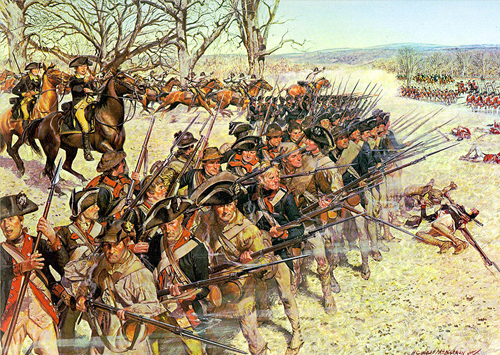
10. Cornwallis at Guilford Court House
Lord Cornwallis had fought in America since 1776 and was no stranger to combat. When his forces closed with Americans under Major General Nathaniel Greene at Guilford Court House on March 15, 1781, the aggressive Cornwallis instinctively led from the front. The British attack appeared to be succeeding until it hit soldiers who didn’t fall back in the second American defensive line. Cornwallis was at the head of his line as he ordered a charge against the hard-fighting Virginia Militia Brigade. Not one, but two horses were shot from under him. British Sergeant Roger Lamb remembered that he saw Cornwallis riding on a commandeered dragoon’s horse, “unconscious of his danger,” about to be surrounded, and “perhaps cut to pieces or captured.”[10] An advancing line of British infantry gave Cornwallis some relative safety. Guilford Courthouse was a Pyrrhic British victory and Cornwallis went on to gain more fame as Washington’s final battlefield opponent at Yorktown. This is just a short list of some of the more prominent commanders that put themselves in harm’s way during the Revolution. If you know of another example, let us know!








11 Comments
Thanks for the provocative article. Since you invite more suggestions, the two that quickly come to mind are Washington trying to rally his troops as the British landed at Turtle Bay following the retreat from Brooklyn. The other would be Arnold at Saratoga. His wound was enough to render him hors de combat but it didn’t kill him. Ironically, that miss may have killed Major John Andre, Sir Henry Clinton’s much favored aide. While not in your category of hits and misses, there was also the reported “shot not taken” when Patrick Ferguson at Brandywine had a high-ranking officer in his sight but decided not to take the easy shot. Though not definitively documented, the case can be argued that the lucky officer was Washington.
Steven,
I like very much your comment about Arnold’s wound – and it’s later effect on John Andre.
I think we need to address that “shot not taken” by Ferguson. I’ve read – long ago – both sides and came away thinking it was not Washington but some other officer. But, it would be interesting to delve into the story.
I believe rather than “Turtle Bay” you had meant to write “Kip’s bay” where Washington was so incensed by his retreating men that his aides led his horse (and GW) away from the front where he was exposed to enemy fire.
GW, at Princeton, if I remember correctly also exposed himself to enemy fire while rallying his men in a reckless manner. Quite a man was GW!
As a native New Yorker I’m embarrassed to have mixed Turtle with Kip’s. The two “Bays” border each other, the former being immediately north of the other.
Per the 1767 Lt. Bernard Ratzer map Kips Bay was 1/2 mile South of Turtle Bay. Turtle Bay used to be located just about where the United Nations is now. Correct me if I’m wrong but I don’t believe any vestige of either bay still exists.
Wikipedia has a quaint image of Turtle Bay in the mid-19thC. I believe both “Bays” went the way of Boston’s Back Bay. Land fill.
Steven and Hugh –
As always, you both bring up great points.
Arnold’s wounding at Saratoga was a strong candidate for the list! Because as you mention, it took him out of combat for some time, which contributed to his disgruntlment and led to his assignment in Philadelphia, two steps that put him on the path to treason. I bumped this shot to include some lesser-known situations, but Arnold’s wound at Saratoga was definitely fateful.
I also considered the famous story of Ferguson’s “shot not taken” at Brandywine. But in his excellent book “With Zeal and Bayonets Only,” Matthew H. Spring posits that the officer that Ferguson drew a bead on at Brandywine may not have been Washington.
There are other “shot not taken” situations that are equally interesting to ponder. For exmaple, there is a an American marksman had Arnold in his sights outside Richmond in 1780, but Lafayette prevented him from taking the shot.
The story of Ferguson’s shot (or not) at Washington comes from a letter written by Ferguson to his brother. He only saw an officer on a horse in Hussar dress. A doctor who was later tending to Ferguson’s arm gave him the notion that it might have been Washington. Apparently, from that point, Ferguson told the story as certain to be Washington.
However, James Delancey who was on the field with Ferguson and was acquainted with Washington identified the Hussar as Pulaski. I believe this bit of info actually comes from James Fenmore Cooper in the appendix to one of his books. If memory serves, he was married to Delancey’s daughter or granddaughter.
Thanks Wayne. Regarding Washington being the officer in question, in “With Zeal and Bayonets Only,” Spring said, “the circumstances make this unlikely.” Your explanation ties it up nicely.
Interesting compilation, Wayne. It does make one wonder how different things might have been with slightly different ballistics.
On a mostly selfish note, one of my wife’s ancestors, Captain Jacob Cheeseman, died with Montgomery and is depicted on the ground in front of the general in Trumbull’s “Death of General Montgomery.” One of the dozen or so killed in that artillery blast, he rests with most of the others up the street to the right just inside Porte St. Louis in Quebec City. Montgomery’s remains actually lie in New York having been taken there on the steamboat “Phoenix” in 1818. As an aside, that steamboat burned in 1819 and is accessible by divers as part of an underwater archaeological preserve in Lake Champlain.
I’m glad you like the compilation, Mike. Thanks for that interesting story about Capt. Cheeseman. I understand that Montgomery’s column passed one unmanned blockhouse on their way into Quebec, so naturally they had some momentum by the time the they encountered the second blockhouse, which was unfortunately well manned, at about 3:00 AM. Capt. Cheeseman was certainly a brave man, being so far forward, and he paid for it with his life. One cannot help but wonder what leadership role he might have gone on to play in the Revolution.
Lt Colonel William Washington at Eutaw Springs.
“Major General Nathanael Greene then sent Lt. Col. Washington’s cavalry to deal with Major Majoribanks, but penetrating the woods with horses was too difficult, so Lt. Col. Washington tried to encircle and rout, thus exposing himself to dangerous fire. His horse was shot from under him, he himself was wounded, and his company practically ravaged. When a hand-to-hand fight developed, a British soldier poised his sword over the wounded Lt. Col. Washington, but Major Majoribanks saw this and gallantly turned it aside. Washington was now his prisoner.” from Carolana.com